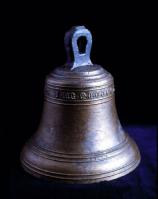Preserving the past: XMaS scientists investigate the protection of historic artefacts

 Like a disease spreading through the body, the corrosion of metals that make up pieces of great historical and cultural importance attacks slowly and it can be some time before potentially irreparable damage is obvious to even a trained eye.
Like a disease spreading through the body, the corrosion of metals that make up pieces of great historical and cultural importance attacks slowly and it can be some time before potentially irreparable damage is obvious to even a trained eye.
At XMaS, the world leading x-ray scattering beamline in Grenoble, scientists from the Universities of Warwick and Ghent recreate conditions on land and at the bottom of the sea to study natural corrosion processes and how they can be prevented. Everything from 13th century organ pipes to lead bullets fired by crew members of the Mary Rose are under investigation as science lends its helping hand in the race to preserve these precious pieces of history.
Whilst rusting in iron rich artefacts is the most commonly recognised type of corrosion, nearly all materials will be damaged over time by even the most seemingly harmless environment. The combination of water and oxygen in the air alone can permanently corrode pieces. As a result those involved in cultural heritage are very interested in new preservation techniques to prevent further damage.
XMaS employs a variety of x-ray analytical methods, operated in parallel, to allow scientists to expose samples to realistic corrosive environments and study in real time the damage that is being done down to the atomic scale. With this capability it acts as a powerful international resource for study of the effectiveness of existing methods and the potential of new techniques, whilst the understanding it provides on how metals are corroded over time is underpinning attempts to restore artefacts to former glories.
Amongst a wealth of research conducted in this area, recent experimental runs have seen items recovered from the famous Tudor Warship, the Mary Rose placed under the XMaS ‘microscope’. These include small lead balls that were fired from the crew’s guns and specially designed to pierce enemy armour. Their findings shed new light on how these and other lead artefacts have been damaged by hundreds of years on the sea floor, vital insights for those attempting to remove harmful corrosion products such as lead chloride that continue to degrade them.
Another area of investigation is heritage lead, for example as found in church organs across the EU. The organ pipes are corroded over time by organic gases from the oak structures which supply the air, causing the precious pipes to rot from the inside out. Overtime this degradation causes the organs to lose their quality of sound.
The successful adaption of XMaS for studying cultural heritage is a result of innovative new techniques that are changing the way research on precious artefacts is carried out around the world. Innovations include a new type of environmental cell, inside of which you can expose samples to all manner of corrosive liquids or gases and realistically mimic the harmful environments at the bottom of the sea.
The team at XMaS are also piloting a new microscope technique known as X-ray Excited Optical Luminescence where x-rays excite visible light out of the sample which can be captured. As different compositions give out different light energies, this technique will allow scientists to draw detailed chemical maps of each sample, looking for the first signs of corrosion.
“Whilst the new techniques developed at XMaS have been designed to meet challenges in cultural heritage, their potential applications stretches across a far greater variety of scientific fields”, says Prof Mark Dowsett, from the University of Warwick who jointly run XMaS along with the University of Liverpool. “Studying one- off works of great historical importance which you can’t simply cut in half provides its own unique challenges and it’s in overcoming these that you get great new ideas. The successful adaption of XMaS for this very specific area of research is a testament to the flexibility of the instrument and the ingenuity of the team behind it.”
